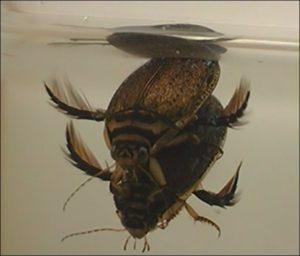What does the swimming beetle eat: a ferocious waterfowl predator
When you mention beetles, either cute insects that feed on flower nectar or Colorado potato beetles that eat leaves on potato bushes come to mind. However, the diversity of the Coleoptera order is so huge that many unique and amazing creatures can be found among them. One of these are swimmers - predatory beetles that live under water.
Content
What swimmers look like: photo
Who are swimming beetles
Name: Swimmers
Latin: DytiscidaeClass: Insects - Insecta
Squad: Coleoptera - Coleoptera
 | Habitats: | standing water, wetlands |
 | Dangerous for: | small crustaceans, fry |
 | Means of destruction: | a number of families need protection |
Swimmers are a large family Zhukovthat live in various water bodies. There are more than 4000 different representatives of this family in the world, and about 300 species of swimmers were found on the territory of Russia.
Appearance and structure of swimmers
| Body shape | Swimmers are very well adapted to life under water. Their body has a flat, streamlined shape and on its surface there are almost no fibers or bristles, which significantly increases the speed of their movement in the water column. |
| Length and color | The body length of adult swimmers in different species can range from 1 to 50 mm. Body color is almost always uniform and can vary from red-brown to black. In some species, subtle spots and stripes may be present in the color, as well as a bronze sheen of the upper body. |
| Eyes and whiskers | The eyes of swimmers are located at the edges of the head. In some members of the family, the organs of vision are very poorly developed or reduced. The antennae of the insect have a filiform shape, consist of 11 segments and are located above the eyes. |
| oral apparatus | Since swimmers are predators, their mouthparts are well adapted for eating animal food. The mandibles of the beetle are not large in length, but powerful and strong enough, which allows them to easily cope with fry, tadpoles and other small inhabitants of reservoirs. |
| Limbs | The front and middle pair of legs of the swimmer are relatively short and not particularly adapted for swimming. The back pair of swimming limbs is responsible for moving under water. The femurs and tibiae of these legs are quite long and considerably flattened. They also have a special hairline that helps the insect to row under water. |
| Wings | Despite the underwater lifestyle, most swimmers have well-developed wings, and they even use them for flights. This ability helps insects move between different bodies of water. Only in a small number of species, the flying wings are reduced. |
Differences between males and females
In all species of swimmers, sexual dimorphism is well expressed. The main difference between males and females is the presence of special suckers on the front pair of legs of males. Suckers can vary greatly in shape and size, but the purpose of this organ is always the same - to hold the female during mating. In some varieties of swimmers, there may be other differences between individuals of different sexes:
- the presence of a stridulatory apparatus in males;
- various forms of anal sternitis;
- coarser microsculpture on pronotum and elytra of female;
- the presence of a glossy sheen on the body of the male;
- different color of elytra in males and females.
Lifestyle of swimmers
At almost all stages of development, swimmers live under water, with the exception of pupae. These insects feel great in various water bodies and have learned not only to survive in such conditions, but also to actively hunt the weaker inhabitants of the “underwater kingdom”.
Swimmers do not know how to receive oxygen from water, but they can carry small reserves of it under their elytra.
The spiracles of swimmers are located on the upper side of the abdomen, making it very convenient for them to take in air without floating completely to the surface. To take a breath and replenish supplies, it is enough for a swimmer to put the posterior end of the abdomen out of the water for a short time.
Adults and larvae of swimmers are predators and boast a very good appetite. Their diet includes small inhabitants of water bodies:
- dragonfly larvae;
- Bugs;
- crustaceans;
- worms;
- shellfish;
- tadpoles;
- frogs;
- fish caviar.
The swimmers themselves can also become someone's dinner. Among the animals that feed on these beetles include:
- fish;
- waterfowl;
- small mammals.
Diving habitat
Representatives of the swimming family are found almost all over the world, and more than 100 endemic species live in Australia. Beetles can live in a wide variety of water types, such as:
- rivers;
- lakes;
- springs;
- rates;
- streams;
- artificial ponds;
- swamps;
- irrigation ditches;
- fountain pools.
Swimmers prefer stagnant or slow-flowing water bodies, but some species feel great even in fast, mountain rivers.
The value of swimmers in nature
Members of the swimming family can be both beneficial and harmful. For example, the diet of some large species consists of small fish and fry. In the event of a significant increase in the number of predatory insects, the population of many fish may be threatened.
As for the benefits, there are several types of swimmers that massively eat the larvae of two-winged harmful insects. In addition, many species included in the diet of these beetles are carriers of a dangerous infection - malaria.
https://youtu.be/LQw_so-V0HM
Conclusion
Swimmers are a unique family of beetles that have managed to conquer not only the airspace, but also the underwater world. In some small reservoirs, these beetles even managed to occupy a niche of top predators. This once again proves that nature is capable of much.
Previous
